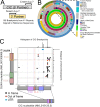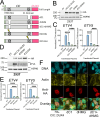This is a preprint.
The Capicua C1 Domain is Required for Full Activity of the CIC::DUX4 Fusion Oncoprotein
- PMID: 38895482
- PMCID: PMC11185703
- DOI: 10.1101/2024.06.06.597815
The Capicua C1 Domain is Required for Full Activity of the CIC::DUX4 Fusion Oncoprotein
Update in
-
The Capicua C1 Domain Is Required for Full Activity of the CIC::DUX4 Fusion Oncoprotein.Cancer Res Commun. 2024 Dec 1;4(12):3099-3113. doi: 10.1158/2767-9764.CRC-24-0348. Cancer Res Commun. 2024. PMID: 39530749 Free PMC article.
Abstract
Rearrangements between genes can yield neomorphic fusions that drive oncogenesis. Fusion oncogenes are made up of fractional segments of the partner genes that comprise them, with each partner potentially contributing some of its own function to the nascent fusion oncoprotein. Clinically, fusion oncoproteins driving one diagnostic entity are typically clustered into a single molecular subset and are often treated a similar fashion. However, knowledge of where specific fusion breakpoints occur in partner genes, and the resulting retention of functional domains in the fusion, is an important determinant of fusion oncoprotein activity and may differ between patients. This study investigates this phenomena through the example of CIC::DUX4, a fusion between the transcriptional repressor capicua (CIC) and the double homeobox 4 gene (DUX4), which drives an aggressive subset of undifferentiated round cell sarcoma. Using a harmonized dataset of over 100 patient fusion breakpoints from the literature, we show that most bona fide CIC::DUX4 fusions retain the C1 domain, which is known to contribute to DNA binding by wild type CIC. Mechanistically, deletion or mutation of the C1 domain reduces, but does not eliminate, activation of CIC target genes by CIC::DUX4. We also find that expression of C1-deleted CIC::DUX4 is capable of exerting intermediate transformation-related phenotypes compared with those imparted by full-length CIC::DUX4, but was not sufficient for tumorigenesis in a subcutaneous mouse model. In summary, our results suggest a supercharging role for the C1 domain in the activity of CIC::DUX4.
Figures





Similar articles
-
The Capicua C1 Domain Is Required for Full Activity of the CIC::DUX4 Fusion Oncoprotein.Cancer Res Commun. 2024 Dec 1;4(12):3099-3113. doi: 10.1158/2767-9764.CRC-24-0348. Cancer Res Commun. 2024. PMID: 39530749 Free PMC article.
-
First Generation Tools for the Modeling of Capicua (CIC) - Family Fusion Oncoprotein-Driven Cancers.bioRxiv [Preprint]. 2025 May 14:2025.05.13.653825. doi: 10.1101/2025.05.13.653825. bioRxiv. 2025. PMID: 40463157 Free PMC article. Preprint.
-
Negative MAPK-ERK regulation sustains CIC-DUX4 oncoprotein expression in undifferentiated sarcoma.Proc Natl Acad Sci U S A. 2020 Aug 25;117(34):20776-20784. doi: 10.1073/pnas.2009137117. Epub 2020 Aug 11. Proc Natl Acad Sci U S A. 2020. PMID: 32788348 Free PMC article.
-
Molecular and therapeutic advancements in Capicua (CIC)-rearranged sarcoma.Front Cell Dev Biol. 2024 May 31;12:1416697. doi: 10.3389/fcell.2024.1416697. eCollection 2024. Front Cell Dev Biol. 2024. PMID: 38882060 Free PMC article. Review.
-
High-grade undifferentiated small round cell sarcoma with t(4;19)(q35;q13.1) CIC-DUX4 fusion: emerging entities of soft tissue tumors with unique histopathologic features--a case report and literature review.Am J Case Rep. 2015 Feb 16;16:87-94. doi: 10.12659/AJCR.892551. Am J Case Rep. 2015. PMID: 25683183 Free PMC article. Review.
References
Publication types
Grants and funding
LinkOut - more resources
Full Text Sources
Research Materials
Miscellaneous
